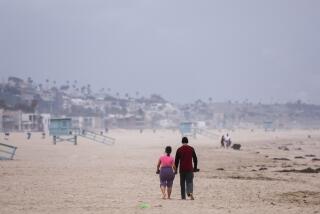The Coast Isn’t Clear : Heavy Fog Cuts Into International Surf Competition
- Share via
HUNTINGTON BEACH — Looking down at the waves below, 28-year-old professional surfer Noah Budroe stood on the Huntington Beach Pier Thursday morning feeling frustrated.
Instead of riding waves and showing maneuvers for judges, Budroe and other participants in the World Surfing Games were forced to cool their heels for more than three hours because of a thick fog that stubbornly clung to the coastline until almost noon.
The fog rolled in again less than five hours later, causing an abrupt end to the sixth day of competition.
“This is not exactly helping our surfing,” said Budroe, a resident of Hawaii. “It kind of messes things up because you want to stay focused and keep your mind on what you have to do.”
Although the surfing conditions were excellent, the judges simply couldn’t see the surfers through the fog with visibility reduced to about 200 yards from the shore.
But the marine layer is expected to start to lift today, allowing the largest international surfing contest in history--which ends on Sunday--to proceed on schedule, forecasters said.
The fog has been hovering along the coast all week, but was at its heaviest on Thursday. It caused the landings of four early-morning flights at John Wayne Airport to be delayed by at least 15 minutes, but no takeoffs were affected, said airport spokeswoman Pat Ware.
The fog is caused by a warm layer of air that is trapped about 200 feet off the ground, preventing cool air from the ocean from rising above it, said Curtis Brack, a meteorologist with WeatherData, which provides forecasts for The Times.
The fog has been mostly confined to the coastline while temperatures have stayed in the mid to upper 70s inland.
“It’s strange,” said Huntington Beach Marine Safety Lt. Steve Davidson. “Across Pacific Coast Highway, it is clear as a bell.”
Peter Wilson, a World Surfing Games judge from South Africa, said surfing heats were being shortened from 20 minutes to 15 minutes in order to complete the contest by Sunday.
“It’s just a pity with this mist,” Wilson said. “This is something quite unusual from an international point of view.”
For spectators eager to see world-class surfing, the fog was also annoying.
“It’s frustrating,” said 48-year-old Ron Rumford, who ate breakfast at the Sugar Shack on Main Street during part of the morning delay. “The surf has just been tremendous with the swell coming through every day. But fog is standard operating procedure this time of year.”
Lifeguards also had trouble doing their jobs.
“Our concern is not being able to see people who choose to surf,” Davidson said. “They can see well enough to surf, but if they have some problem out there, hopefully some other surfer can see them to help them out. We just want people to take into consideration that when they go into the water, lifeguards can’t see them.”
(BEGIN TEXT OF INFOBOX / INFOGRAPHIC)
In Case You Mist It
A large high- pressure system has helped trap humid air moving inland, producing foggy mornings. Here’s how it happens:
1. Ground cools during the evening.
2. Wind moves humid air inland, across cool ground.
3. Air temperature drops to the dew point and fog forms.
4. When sun rises, it heats air temperature above dew point and fog disappears.
What’s a “Dew Point?”
Dew point is the temperature at which air willnot accept additional moisture. Water molecules, which have been circulating as gas, lose energy as temperature drops and condensation produces water dropletls-dew.
Source: WeatherData
More to Read
Sign up for Essential California
The most important California stories and recommendations in your inbox every morning.
You may occasionally receive promotional content from the Los Angeles Times.













